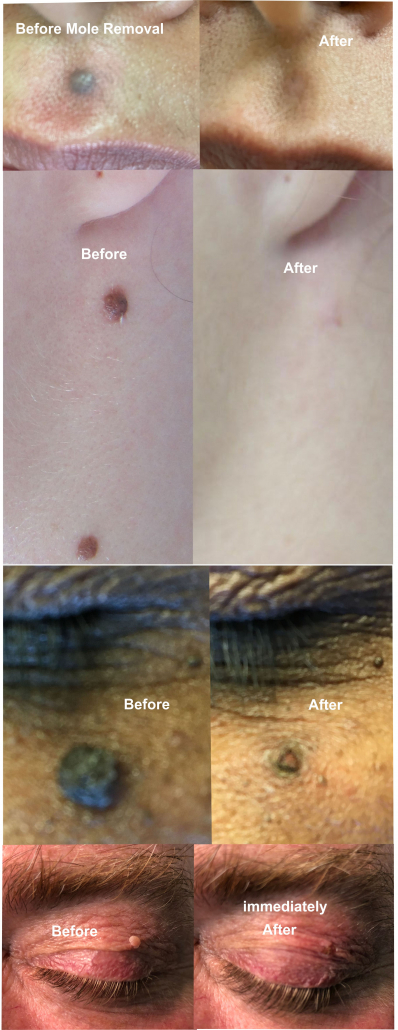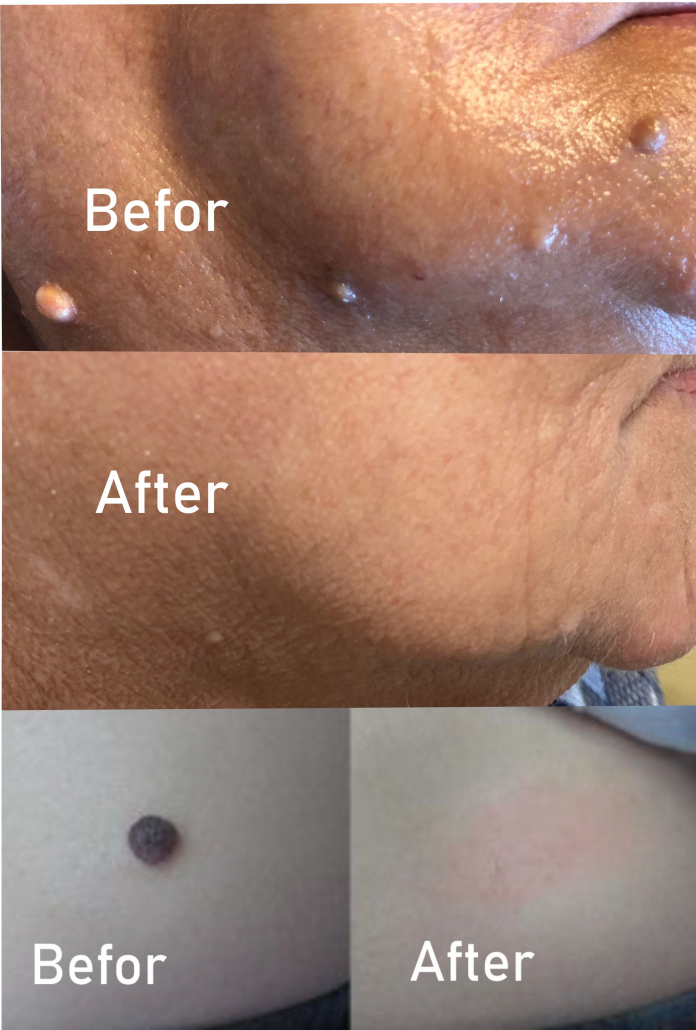
SKIN TAGS, MOLES, PAPILLOMAS & WARTS REMOVAL TORONTO

SKIN TAGS, OR PAPILLOMAS & WARTS REMOVAL TORONTO
What are Skin Tags?
Skin tags, also known as papillomas, are common benign growths that appear on the skin that can be easily treated and removed.
Skin tags are small flaps of skin that are connected to the body by a thin stalk of tissue called a peduncle. While the presence of skin tags can be concerning, they are typically harmless and benign growths. Skin tags rarely cause symptoms unless they are irritated by repeated rubbing or scratching. In some cases, larger skin tags may burst under pressure, and activities like shaving or wearing certain types of jewelry or clothing can contribute to their formation or ruptures. Overall, while skin tags can be visually bothersome, they are generally benign and do not pose significant health risks.
Where do Skin Tags usually Growth?
They are commonly found in the skin folds of areas such as the neck, groin, underarms, eyelids, and upper chest, although they can appear elsewhere on the body.
Who is prone to Develop Skin Tags?
Studies from the American Osteopathic College of Dermatology (http://www.ijord.com)
indicate skin tags occur in as much as half the adult population. Although skin tags can develop in anyone, they are more commonly acquired during adulthood rather than being present at birth. As individuals age, both men and women tend to develop more skin tags, with their prevalence increasing up to around the age of 60.
Associated Risk
Although skin tags are generally considered harmless, recent research at the International Journal of Research in Dermatology has uncovered a significant association between skin tags and metabolic syndrome, particularly insulin resistance or type 2 diabetes. Insulin resistance occurs when the body struggles to transport sugar into cells, leading to elevated blood sugar levels. Consequently, the body produces excess insulin in an attempt to normalize blood sugar. Early detection of insulin resistance is crucial for effective prevention and treatment of this condition.
Having skin tags also raises the likelihood of having higher levels of triglycerides,
C-reactive protein (CRP), a marker for inflammation, blood sugar, and elevated cholesterol.
Certain individuals are predisposed to developing skin tags and may experience periodic growth. This is why some individuals may require regular skin tag removal procedures at annual intervals. Love Your Skin Book (http://bitly.ws/EgxK).
What causes skin tags?
- Being overweight;
- Heredity;
- Friction of skin against skin;
- Too much sugar in the blood;
- High levels of cholesterol;
(i.e. All those at risk for diabetes and cardiovascular disease).
How are skin tags removed?
Electrocautery and Laser treatment are two methods commonly used for skin tag removal. Here’s how each of these treatments works.
Electrocautery a highly effective method involves using a gentle high-frequency electrical current to burn off and remove skin tags in just a single session. The procedure starts by cleaning the area around the skin tag and, if necessary, applying a local anesthetic to numb the area. A small probe or needle with an electric current is then used to cauterize the skin tag, and burning it off effectively.
Laser treatment is often used for flat skin tags. During the procedure, a focused laser beam is applied to the skin tag. The laser energy is selectively absorbed by the pigment in the tag, causing it to heat up and ultimately destroy the tag. The destroyed skin tag will then naturally shed away over time. Multiple laser treatment sessions, usually around two, may be required to ensure complete removal. The number of sessions needed may vary depending on the size and location of the skin tag. Local anesthesia is usually not required for laser treatment of skin tags.
If you have concerns about skin tags or want them removed for cosmetic reasons, it is advisable to consult with a dermatologist or healthcare professional who can provide appropriate guidance and treatment options.


What are the differences between a skin tag and a mole?
Skin tags typically appear on the surface of the skin, whereas moles tend to be situated deeper within the skin layers. Skin tags are generally considered benign, meaning they are non-cancerous. On the other hand, moles can potentially be precancerous and have the potential to develop into melanoma, a type of skin cancer (https://cancer.ca/en/).
It’s important to note that exposure to the sun’s ultraviolet (UV) rays can contribute to the development of new moles or the transformation of existing ones into melanoma (Symptoms & causes). Therefore, it is crucial to apply sunscreen protection to the skin from excessive sun exposure and take precautions to minimize the risk of skin cancer (mayoclinic.org).
Regular self-examination of your moles is highly recommended, and if you have any concerns, it is advisable to consult with your doctor who can evaluate and address them appropriately.
What are Warts and What Causes Them?
Warts are skin growths caused by the human papillomavirus (HPV), a virus that typically enters the body through broken skin. The virus stimulates the rapid growth of the top layer of skin, resulting in the formation of a wart. The dark spots that are sometimes visible in a wart are actually tiny blood vessels that supply blood to the growth.
Where can Warts Appear?
Warts can develop on any part of the body. Common warts are often found on the hands but can emerge almost anywhere. Plantar warts specifically grow on the soles of the feet and can be painful due to the pressure exerted on that area.
Are Warts Contagious?
Yes, warts are contagious. HPV or Human papilloma Virus is responsible for warts and can spread to other parts of your own body by direct contact or through sharing personal items such as towels or razors. It can also infect other individuals. Although warts are typically painless, the virus is quite persistent, taking months to disappear if left untreated.
Finally, if you have concerns about skin tags, moles, or warts, it is advisable to seek advice from a dermatologist or healthcare professional who can provide appropriate guidance and treatment options.
At Nell Clinic, we specialize in the removal and treatment of skin tags and warts using state-of-the-art Nd: Yag Laser technology from Cutera Laser Company, as well as Electrocautery. Our methods have proven to be highly effective in achieving successful outcomes.
WHAT CLIENTS SAY ABOUT US

Consultations Are FREE
Book Your Appointment Today
Book Your Appointment Today
